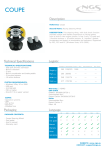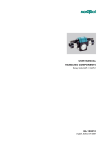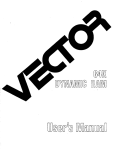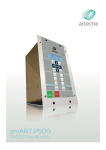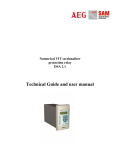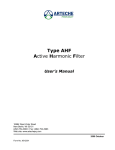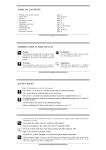Download latching auxiliary relays
Transcript
LATCHING AUXILIARY RELAYS This document may be subject to changes. Contact ARTECHE to confirm the characteristics and availability of the products described here. Moving together INDEX 4. › Answers for any application 5. › General characteristics 6. › Technical standards 7. › Range of products 9. › General purpose latching relays 10. › Latching and lockout relays I 11. › Latching and lockout relays II 12. › Latching relays with coil overvoltage protection 13. › Breaking capacity 18. › Pick-up voltage/release voltage-temperature charts 20. › Model selection 22. › Dimensions and panel mounting cut-off . Auxiliary Relays | Latching aplications 3 ANSWERS FOR ANY APPLICATION ARTECHE latching relays are relays whith 2 stable position for the output contacts. Depending on which coil is energized, the output contacts will change from one position to another. The design of Arteche relay allows to have no consumption in permanence. ARTECHE latching relays range are designed to guarantee the best features and complete security even in the hardest working environment. The design, durability and quality of the different alternatives that ARTECHE latching relays can offer (FF range and standard range), make them suitable for high responsibility controls in different areas, highlighting: ELECTRICAL UTILITIES: Power plants, electrical substations. › › › Position monitoring of circuit breaker and sectionalizer › Galvanic isolation between the control system and the primary equipment › › › › Applications where high speed operation is a must Direct operation on MV / HV (circuit breaker, sectionalizer) Position memory: - manual / automatic - local / remote Applications where high breaking capacity is required Tripping and lockout functions Low duty loads control, activate digital inputs. FF range RAILWAY SECTOR: Electrification, signalling, interlocking and rolling stock. › › › › › Boarding doors locking Brake circuit command Lighting and air conditioned systems operation Traction system Low duty loads control, activate digital inputs. FF range INDUSTRIAL SECTOR: Continuous process industries (Petrochemical, concrete, iron industries), water treatment, ... › › › Critical process surveillance › › Low duty loads control, activate digital inputs. FF range 4 Position monitoring circuit breaker and sectionalizer Galvanic isolation between the control and the power systems Activation of security sistems in industrial processes: - bloking electrical machines The great power of the output contacts makes possible direct action on HV and MV switchgear, because their making/breaking capacities, continuous through-current and overvoltage capacity guarantee perfect insulation. Auxiliary Relays | Latching aplications GENERAL CHARACTERISTICS The main features of ARTECHE’s latching auxiliary relays are the followings: › Designed to allow continuous operation even in high temperature ambient, within the whole voltage range. › › › No consumption in permanence. › Availability of extended voltage range (+25/-30%) for high security applications. › Capable to operate under low duty loads, activate digital inputs, and operate without any load. FF Range. › › High speed operation (up to 10 ms). › › › Sturdy design. › In compliance with the most demanding test standards: IEC, EN, IEEE and bearing the CE mark. › Wide range of auxiliary voltage levels (Vdc and Vac). › Up to 16 output contacts in one single relay for contact multiplication (ask for technical characteristics of the 16 contacts model). › Simplicity of installation (plug-in relays in a wide range of sockets with different installation configurations). › Capable to work under ambient of 100% humidity. › No need of maintenance after installation. Self-cleaning contacts. High level of electrical insulation between input and output circuits. Capable to withstand vibrations and seismic conditions. Front state indication on the nameplatte. High protection degree (IP40), with transparent cover, making them suitable for use in salty and tropical atmospheres. Large variety of assemblies with frontal and rear connection sockets by screw or fast-on clip. Auxiliary Relays | Latching aplications 5 TECHNICAL STANDARDS RAILWAY APPLICABLE STANDARDS › EN 60077 Series. Rolling stock equipment. - Part 1: General conditions in service and general terms. - Part 2: Electrotechnical components. › IEC 50155 (IEC 60571 equivalente). Railway applications - Rolling stock equipment. GENERAL STANDARDS In addition to the specific applicable standards, ARTECHE latching relays are designed based on the fulfilment of the following standards: › › › › IEC 61810: Electromechanical all-or-nothing relays. IEC 60255: Electrical relays. Measuring relays and protection equipment. IEC 61812: Specified time relays for industrial use. IEC 60947: Low-voltage switchgear and controlgear. E322124 UL Recognized Component Marks for USA and Canada: The combined UL signs for the USA and Canada are recognized by the authorities of both countries. All auxiliary relays identified with this mark meet the requirements of both countries. 6 Auxiliary Relays | Latching aplications RANGE OF PRODUCTS General purpose latching relays The bistable ARTECHE relays with 2 stable positions. These positions are held by a permanent magnet, which prevents intermediate positions, giving a huge security operation. The position change is made with 2 sets of coils with separate entrances in BF3 and BJ8 and with breaking-flame contacts for each set of coils. Their pick-up time lower than 20 ms and the high breaking capacity of their contacts make them appropriate to be used as an interface between the protection system and the breaker. The main application for these relays is multiply the output contacts in those controls that need to memorite 2 stables positions: - automatic / manual - close / open Auxiliary trip and lockout relays ARTECHE offers specific relays intended to be used in tripping and lockout applications, where high quality requirement in operating time (with models that assure the trip ever in less than 10 ms) and breaking capacity are needed. Front indication on the nameplatte, that indicate if the relay has changed the contact positions. All the relays include a diode in parallel with the coil (see bistable relays with overvoltage protection characteristic). There is also the possibility of a bistable trip and lockout relay with manual reset. Latching relays with coil overvoltage protection ARTECHE’s auxiliary relays, either Vdc or Vac, have the possibility of including an element in parallel with the coil (diode or varistance). These elements aimed to prevent the over voltage peak generated by the coil itself and it may could affect other equipment installed on the same line. Auxiliary Relays | Latching aplications 7 TECHNICAL FEATURES PER MODEL › World-class range of auxiliary relays for energy sector, specially designed for the most demanding applications 8 Auxiliary Relays | Latching aplications GENERAL PURPOSE LATCHING RELAYS Model BF-3 BF-4 BJ-8 Relays with two stable positions. Required when the position memory (open-close, automatic-manual, local-remote...) is needed. Applications Construction characteristics Contacts no. 3 Changeover 4 Changeover 8 Changeover 11 10 21 Connections Set + 14 10 + 2 1 Reset 9 13 8 12 7 11 5 Set 4 2 3 Options Weight (g) Dimensions (mm) + B1 + 1 Reset 10 14 9 13 8 12 7 11 20 31 30 41 40 51 50 6 5 4 3 Set + a b + c d Reset 61 60 71 70 81 80 Options are not available 1 2 3 4 5 6 7 8 300 600 45 x 45 x 96,5 (F short Type) 90 x 50 x 100,5 (J short Type) Coil characteristics Standard voltages(1) 24, 48, 72, 110, 125, 220 Vdc / 63,5, 110, 127, 230 Vac (50-60 Hz) Voltage range Pick-up voltage Consumptions only in the change-over +25% -30% UN See pick-up voltage / temperature curves for Latching relays ≤6 W ≤12 W Operating time Pick-up time <20 ms Contacts Contact material Distance between contacts Permanent current Instantaneous current Max. making capacity Breaking capacity Max. breaking capacity Umax opened contact AgNi 1,8 mm 10 A 80 A during 200 ms / 200 A during 10 ms 40 A / 0,5 s / 110 Vdc See breaking capacity curves (1 contact configuration) See value for 50.000 operations 250 Vdc / 400 Vac Performance data Mechanical endurance 107 operations Operating temperature -40ºC +70ºC Storage temperature -40ºC +70ºC Max. operating humidity 93% / +40ºC Operating altitude(2) (1) (2) <2000 m Other voltage upon request Ask for higher altitudes Auxiliary Relays | Latching aplications 9 TRIP AND LOCKOUT RELAYS (I) Model Applications BF-3R BF-4R BJ-8R Intended for trip and lockout applications where high demanding requirements in operating time and breaking capacity are needed. Construction characteristics Contacts no. 3 Changeover Set Connections 10 1 Reset 9 + 13 14 8 + 12 2 7 11 4 Changeover Set 5 4 3 Reset Options 11 10 21 20 31 30 41 40 51 50 61 60 71 70 81 80 6 10 14 9 13 8 12 7 11 Set + a b + d c Reset 5 4 3 1 2 3 4 5 6 7 8 Options are not available Weight (g) Dimensions (mm) + B1 + 1 2 8 Changeover 300 600 45 x 45 x 96,5 (F short Type) 90 x 50 x 100,5 (J short Type) Coil characteristics Standard voltages(1) 24, 48, 72, 110, 125, 220 Vdc / 63,5, 110, 127, 230 Vac (50-60 Hz) Voltage range Pick-up voltage Consumptions only in the change-over +10% -20% UN See pick-up voltage / temperature curves for Latching relays 27 W 35,5 W 23 W Operating time Pick-up time <10 ms (Vdc) <20 ms (Vac) <10 ms (Vdc) <20 ms (Vac) Contacts Contact material Distance between contacts Permanent current Instantaneous current Max. making capacity Breaking capacity Max. breaking capacity Umax opened contact AgNi 1,8 mm 10 A 80 A during 200 ms / 200 A during 10 ms 40 A / 0,5 s / 110 Vdc See breaking capacity curves (1 contact configuration) See value for 50.000 operations 250 Vdc / 400 Vac Performance data Mechanical endurance 107 operations Operating temperature -40ºC +70ºC Storage temperature -40ºC +70ºC Max. operating humidity 93% / +40ºC Operating altitude(2) (1) (2) <2000 m Other voltage upon request Ask for higher altitudes 10 Auxiliary Relays | Latching aplications TRIP AND LOCKOUT RELAYS (II) Model Applications BF-4RP BJ-8RP Intended for tripping and locking applications where high quality requirements in operating time and breaking capacity are needed, with manual reset. Construction characteristics Contacts no. 4 Changeover Connections Set + B1 + 1 2 Reset 10 14 9 13 8 12 7 11 Options Weight (g) Dimensions (mm) 8 Changeover 11 10 21 20 31 30 41 40 51 50 61 60 71 70 81 80 6 Set + a b + c d Reset 5 4 3 1 2 3 4 5 6 7 8 Options are not available 300 600 45 x 45 x 96,5 (F short Type) 90 x 50 x 100,5 (J short Type) Coil characteristics Standard voltages(1) 24, 48, 72, 110, 125, 220 Vdc 63,5, 110, 127, 230 Vac (50-60 Hz) Voltage range Pick-up voltage (20ºC) Consumptions only in the change-over +10% -20% UN See pick-up voltage / temperature curves for Latching relays 23 W 35,5 W <10 ms (Vdc) <13 ms (Vac) <10 ms (Vdc) <20 ms (Vac) Operating time Pick-up time Contacts Contact material Distance between contacts Permanent current Instantaneous current Max. making capacity Breaking capacity Max. breaking capacity Umax opened contact AgNi 1,8 mm 10 A 80 A during 200 ms / 200 A during 10 ms 40 A / 0,5 s / 110 Vdc See breaking capacity curves (1 contact configuration) See value for 50,000 operations 250 Vdc / 400 Vac Performance data Mechanical endurance 107 operations Operating temperature -40ºC +70ºC Storage temperature -40ºC +70ºC Max. operating humidity 93% / +40ºC Operating altitude(2) (1) (2) <2000 m Other voltage upon request Ask for higher altitudes Auxiliary Relays | Latching aplications 11 LATCHING RELAYS WITH COIL OVERVOLTAGE PROTECTION Model BF-3BB BF-4BB BJ-8BB Intended to protect the contact of the equipment that feeds the coil in our relay. Applications Construction characteristics Contacts no. 3 Changeover Set Connections 10 1 Reset 9 + 13 14 8 + 12 2 7 11 4 Changeover Set 5 4 3 Reset Options Weight (g) Dimensions (mm) + B1 + 1 2 8 Changeover 11 10 21 20 31 30 41 40 51 50 61 60 71 70 81 80 6 10 14 9 13 8 12 7 11 5 4 3 Set + a b + c d Reset Options are not available 1 2 3 4 5 6 7 8 300 600 45 x 45 x 96,5 (F large Type) 90 x 50 x 100,5 (J large Type) Coil characteristics Standard voltages(1) 24, 48, 72, 110, 125, 220 Vdc(3) Voltage range Pick-up voltage Consumptions only in the change-over +25% -30% UN See pick-up voltage / temperature curves for Latching relays ≤6 W ≤12 W Operating time Pick-up time <20 ms Contacts Contact material Distance between contacts Permanent current Instantaneous current Max. making capacity Breaking capacity Max. breaking capacity Umax opened contact AgNi 1,8 mm 10 A 80 A during 200 ms / 200 A during 10 ms 40 A / 0,5 s / 110 Vdc See breaking capacity curves (1 contact configuration) See value for 50,000 operations 250 Vdc / 400 Vac Performance data Mechanical endurance 107 operations Operating temperature -40ºC +70ºC Storage temperature -40ºC +70ºC Max. operating humidity 93% / +40ºC Operating altitude(2) (1) (2) (3) 12 <2000 m Other voltage upon request Ask for higher altitudes Vac voltages upon request Auxiliary Relays | Latching aplications BREAKING CAPACITY › With devices operating worldwide, also heavy industries like oil & gas sector trust in our relays. Auxiliary Relays | Latching aplications 13 BREAKING CAPACITY The breaking capacity is a critical parameter on the design and the applications of the relays. Its mechanical life could be considerably reduced, depending on the value of the load (especially with heavy duty loads), the number of operations and the environmental conditions in which the relay is operating. In any configuration, ARTECHE’s auxiliary relays have a high breaking capacity values. These limits are showed in the table below, in terms of power and current values. In all the cases, these relays guarantee a right performance during 50,000 operations. Likewise, the values showed in the following charts have been obtained in standard conditions in the laboratory, and they could be different in real conditions. In any case, the possibility of connecting serial contacts or a bigger distance between contacts makes these values to be considerably increased. 24 Vdc voltage Different loads configurations. Resistive load: Highly inductive load: › L/R= 0 ms. 107 107 106 106 No. operations No. operations › 105 L/R= 40 ms. 105 104 104 0 5 10 15 Current 20 25 0 2 4 6 8 10 12 Current 1 contact 0 ms 20 ms 40 ms Vdc Contact configuration P(W) I(A) P(W) I(A) P(W) I(A) 24 1 contact 500 20,83 370 15,42 250 10,42 (*) Ask for data and curve of serial contacts 14 Auxiliary Relays | Latching aplications 110 Vdc voltage Different loads configurations. Resistive load: › Highly inductive load: › L/R= 0 ms. 107 No. operations No. operations 107 L/R= 40 ms. 106 106 105 105 104 104 0 1 2 3 4 5 6 7 8 9 10 0 1 2 3 Current 4 5 6 7 Current 1 contact 2 contacts 0 ms Vdc 20 ms 40 ms Contact configuration P(W) I(A) P(W) I(A) P(W) I(A) 1 contact 170 1,55 140 1,27 90 0,82 2 contacts 1,360 12,36 1,106 10,05 730 6,63 110 Auxiliary Relays | Latching aplications 15 220 Vdc voltage Different loads configurations. Resistive load: Highly inductive load: › L/R= 0 ms. 107 107 106 106 No. operations No. operations › 105 105 104 0,00 L/R= 40 ms. 0,20 0,40 0,60 0,80 1,00 1,20 1,40 1,60 104 0,00 0,10 0,20 0,30 Current 0,40 0,50 0,60 0,70 0,80 Current 1 contact 2 contacts 0 ms Vdc 20 ms 40 ms Contact configuration P(W) I(A) P(W) I(A) P(W) I(A) 1 contact 150 0,68 115 0,52 66 0,30 2 contacts 319 1,45 234 1,06 134 0,61 220 16 Auxiliary Relays | Latching aplications HOW TO SELECT THE CURVE OF MY RELAY These charts show the breaking capacity values, either for resistive and highly inductive loads, in three voltage values of reference (ask for other voltage values). The charts show two different curves: › 1 contact: Breaking capacity of the relays with distance between contacts = 1.8 mm. › 2 contacts: Breaking capacity for relays with serial contacts, and distance between contacts=1.8 mm. The distance between contacts is shown in the tables of technical data. HOW THE BREAKING CAPACITY CAN BE INCREASED ARTECHE’s auxiliary relays are power relays, designed specially to have a high breaking capacity. Thus, there are applications where the loads are so high that it is necessary to even increase the breaking capacity, keeping the reliability of the contacts of the auxiliary relays. Thus, ARTECHE relays have the following alternatives and recommendations: › Possibility of external connection of equipment (serial contacts) getting an important increase of breaking capacity in these equipment is shown, guaranteeing the right performance during a high number of operations. Auxiliary Relays | Latching aplications 17 PICK-UP VOLTAGE/RELEASE VOLTAGE-TEMPERATURE CHARTS 18 Auxiliary Relays | Latching aplications Variability of operative voltage range against temperature for the latching auxiliary relays. General purpose latching relays and relays with coil overvoltage protection. GENERAL PURPOSE RELAYS Operative range against ambient temperature. 250 U/UN (%) 200 Upper limit of the pick-up voltage 150 Pick-up voltage limit Operative range of the coil voltage 100 50 0 -40 -30 -20 -10 0 10 20 30 40 50 60 70 80 90 100 110 120 130 Temperature (ºC) TRIP AND LOCKOUT RELAYS Operative range against ambient temperature. 200 160 Upper limit of the pick-up voltage 120 U/UN (%) Pick-up voltage limit Operative range of the coil voltage 80 40 0 -40 -30 -20 -10 0 10 20 30 40 50 60 70 80 90 100 110 120 130 Temperature (ºC) TRIP AND LOCKOUT RELAY WITH PUSH TO RESET BUTTON Operative range against ambient temperature. 200 160 Upper limit of the pick-up voltage U/UN (%) 120 Pick-up voltage limit Operative range of the coil voltage 80 40 0 -40 -30 -20 -10 0 10 20 30 40 50 60 70 80 90 100 110 120 130 Temperature (ºC) Auxiliary Relays | Latching aplications 19 MODELS SELECTION Latching Type Range Range FF(*) Aux. Supply Vdc or Vac. General purpose range BF-3 4 contacts relay BF-4 8 contacts relay BJ-8 Restrictions 3 contacts relay Options Diode in parallel with the coil (only Vdc) BB Fast acting trip and lock out relay (electrical reset only) R Fast acting trip and lock out relay (electrical and manual reset) (**) RP Range FF No - Yes FF Aux. Supply Vdc o Vac Indicate voltage level and if it is VDC or VAC (ex: 24 VDC) (*) Indicate just if FF range is required Trip and lockout (**) Unavailable for 3 contacts Type Range General purpose range BF-3R 4 contacts relay BF-4R 4 contacts relay BF-4RP 8 contacts relay BJ-8R 8 contacts relay BJ-8RP • Restrictions 3 contacts relay • Options With manual reset 20 Auxiliary Relays | Latching aplications Arteche has more than 100 customer service technical points, an expert engineers network close to you everywhere DIMENSIONS OF THE RELAYS Type F Type J F Short J Short 42,5 72 10,5 72 10,5 50,4 50,4 82,5 Relay dimensions F Long J Long 42,5 96,6 *100,5 96,6 10,5 10,5 50,4 50,4 82,5 *depending on the model SOCKETS: DIMENSIONS AND CUT-OUT Sockets Relay BF BJ 22 Options Accessories Type Screw Faston Weight (g) IP10 Front connection FN-DE IP10 FN-DE2C IP10 110 IP20 Front connection FN-DE IP20 FN-DE2C IP20 110 IP20 Rear connection FN-TR OP FN-TR2C OP 90 IP20 Flush mounting F-EMP OP IP10 Front connection JN-DE IP10 JN-DE2C IP10 225 IP20 Front connection JN-DE IP20 JN-DE2C IP20 225 IP20 Rear connection JN-TR OP JN-TR2C OP IP20 Flush mounting J-EMP OP Retaining clips Function signs on the extraction ring 300 180 400 Auxiliary Relays | Latching aplications Relays type F Relays type J 4<237>4<23 17> 8<237>8<23 17> 44 43 Front connection for double faston IP10 sockets 105 64 105 64 84 83 DN-DE2C IP10 FN-DE2C IP10 JN-DE2C IP10 29 32,3 48 Sockets for DIN rail 29 8<237> 8<23 17> 4<237> 4<23 17> (1) (2) 42,7 39,8 32,3 88 31 29 31 29 112 112 82,7 79,8 lateral connection for the rest of the sockets JN-B@=>8<-B@ 1=> 43 84 80 6 41,8 51,2 6 43 51,2 44 40 41,8 FN-B@=>4<-B@ 1=> Sockets for rear connection 40,5 +- 0,2 42 42 80,5 +- 0,2 F3;>=>F-EMP (short) OP 83;>=>83;>(short) OP 80 80 120 75 101,5 101,5 15 12,5 8 Sockets for flush mounting 15 12,5 8 83;>=>83;> (long) OP F3;>=>F-EMP (long) OP 80 80 75 120 124 124 15 12,5 8 15 12,5 8 R2 Cut-out Auxiliary Relays | Latching aplications 4,5 DIN46277/3 (2) 106 96 Cut-out 125 90 min DIN rail according to EN50022 90 min 125 66 57 80 min (1) 4,5 Cut-out Cut-out 90 min 66 57 4,5 66 57 106 96 61 50 Minimum distance between sockets will depend on type of relay and sockets. Please request sockets user manual for more detailed information. 23 MOVING TOGETHER Actualizaciones: ARTECHE_CT_Latching-Auxiliary-Relays_E Versión: A1 www.arteche.com ©Arteche

























